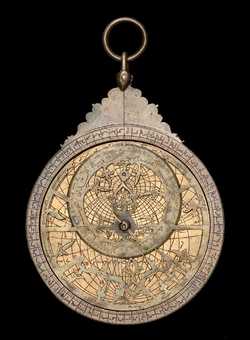Astrolabes /
Browse / 39063
| Date | 1481/2 |
| Maker | Muḥammad Ṣaffār |
| Place | Persia |
| Material | Brass |
| Inventory no. | 39063 |
| Acquisition | Presented by Lewis Evans in 1924 |
View all
images for this astrolabe
View
detailed provenance for this astrolabe
Mater
The mater and limb are of one-piece construction. Scales on the limb: degree scale. More informationBack
There are two different scripts on the back of this instrument: a Kufic and a Nashki style.. The back contains 7 scales of the following types: Altitude; Declination; Sine/Cosine; Cotangent; Shadow square. The back is inscribed: with a maker's signature marked as هذه الأصطرلاب العبد الفقير ٳلى الله الغفار في سنة ست وثمانين وثمان مائة شمس الدين محمد صفار (This astrolabe (was made by) the servant, yearning for God the much-forgiving, Shams ad-Dīn Muḥammad Ṣaffār, in the year 886.). Inscription in the lower half. with a scale label marked as ظل الأصابع عمد ظل الأقدام مديد (The shadow of the fingers is vertical / The shadow of the feet is extended.). Upside down within the shadow square. More informationRete, Pin & Horse
The rete contains 0 stars. The zodiac on the rete is labelled: الحمل , الثور , الجوزا , السرطان , الاسد , السنبله , الميزان , العقرب , القوس , الجدي , الدلو , الحوت .The rete is attached using a pin & horse. The horse is most likely a replacement.. More information
Rules & Alidades
| Type | Details |
|---|---|
| Alidade | Double-ended. The rule is not original. The rule does
not fit the instrument well and appears to be engraved in
a different hand, suggesting that it is not
original.. |



